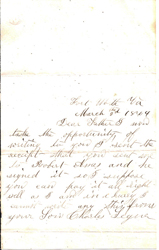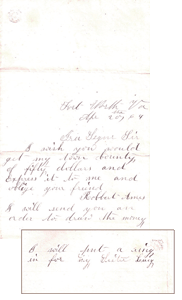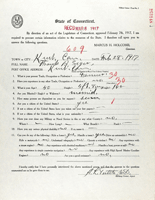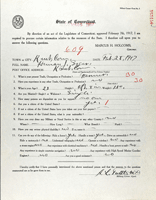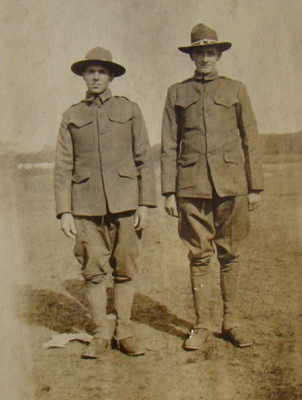Farmer Soldier Farmer…
… a soldier of the Revolution
Ellen Ravens-Seger has provided an affidavit and petition from Joseph Seger (b. 13 Oct 1757, Simsbury, CT; d. 28 Jun 1845, Kent) for a pension for his service in the Revolutionary War. Charlotte Lindsey of the Kent Historical Society has kindly clarified some of the names.
Joseph Seger [the 5th of that name born in North America], born in Simsbury, settled in Kent after the Revolutionary War. My father, Charles, transcribed the below from a 5-page court document archived with the State. Joseph’s application for pension was dated July 31, 1832, but his pension was not received before his death on June 10, 1845.

Many family letters document son Heman’s dogged efforts to obtain the pension, which was, at least partially, paid to Joseph’s surviving children in 1852. Heman also tracked descendants down all over the place to give them their shares. (It must have taken my dad forever to transcribe this as well as he did—it’s pretty hard to read!) Some of the names of the men in the “Kent neighborhood” (near the end) are very hard to read and if [we] can make any corrections “for the record,” I’d appreciate it. I’ve attached a scan of that page (top section), if anybody wants to attempt it. (You can also see Joseph Seger’s signature ahead of the Mills’ certification at the end of the attached.)
News must have traveled fast even in 1832, because according to VA Gen Search:
The full transcribed text of his petition can be read and printed HERE.
Heman made a great effort to help obtain his father Joseph’s Revolutionary War pension, which he did, 7 years (1852) after Joseph’s death (1845).
By that time, Hiram had also died (1848). The pension was $1,370.05. It seems that the pension was split into 5 portions for Joseph’s children—I wonder if only 5 were still alive when the pension was paid in 1852. They are Heman, Elizabeth Smalley, Lydia J. Smith, Hannah Hawes, and 1 other (can’t piece that together yet—Mary Young or Lucy Knapp)?
Company Payroll
A document reproduced in the Elbert Seger genealogy, recording Joseph Seger’s service in the Revolutionary War. Click on the image for a larger version.
26 years later, with Heman’s son Ira as executor of Heman’s estate, Ira began distributing Hannah’s portion of the pension to Joseph’s grandchildren (I’m guessing the ones descended from Heman, Elizabeth, Lydia, and the other, from the surviving documents) who signed that their portion would be returned if Hannah Hawes or her heirs establish a legal claim.
So I wonder if Hannah (who was in OH in 1845), could not be located in 1852 or forever after. I have no documents indicating that Hiram or his descendants are involved in the pension distribution.
A lawyer (L.M. Drusy or Drury) of Canandaigua, NY, who helped secure the pension from the government, received 25% as a fee. He wrote that he spent more than $2,000 in all (presumably he was working on behalf of many veterans) “and more than one year’s labor but I brought about a change in the practice of the Department which has existed for 25 years past and I got all the artificers’ pensions increased.” (An artificer was a military workman in the artillery.)
In comparison, the entire bequest from Joseph Seger’s personal estate to his daughter Lucy Knapp, for which we have a receipt, was $6.54. Thirteen hundred dollars must have seemed like a fortune.
In the midst of this project, the granddaughters of Roscoe Seger sent me links to photographs of Revolutionary War veterans taken in the infancy of photography. Here are links to two articles about that project: here and here.

Courtesy Lilly Library, Indiana University, Bloomington, Indiana.
Ye Parliament of England
An equally cocky song adopted from the Navy
by militiamen during the War of 1812, here sung by Keith McNeill.
1812: the Next Generation
Joseph Seger’s sixth child, Hiram, served in the War of 1812, drafted in Connecticut. Hiram was born and grew up in Kent, eventually married and moved to farm in Wayne, New York, in the Finger Lakes region, and then in the early 1830s applied for and received a grant of 160 acres in Michigan, which was not yet a state. He moved west with his wife and seven children. There are conflicting narratives about one of their sons who fought in the Civil War; the most reliable source appears to be Pioneering Michigan, by Eric Freedman (Northmont Publishing Inc., 1993).
A reference to his military service on American Local History Network: Michigan appears to be derived from the Freedman book.
in 1971 Elbert E. Seger, descendant of Hiram, published Genealogy of the Hiram Seger Family, Pioneer Settlers in Redford, Michigan, based on his research and that of his father Ned. According to Elbert’s research, Hiram was drafted for service and joined up in Stonington, CT. Elbert continues: “The record states that his service was terminated in 30 days when, it is said, injuries sustained when thrown from a horse disabled him. Family tradition states that at that time he was presented with a hand-carved wooden cane by his commander (said cue has subsequently been handed down to succeeding generations of war veterans via: William H. H. Seger, James Seger and Verne Seger, all living in Brighton, Michigan).”
From Pioneering Michigan which cites an otherwise unidentified family history (perhaps that of Elbert):
In 1834, a presidential land grant gave the family 160 acres in Redford, Wayne County, based on Hiram’s status as a military veteran.…
… At age 17, Hiram was drafted in the War of 1812 and wounded in battle. When he was discharged for a disability after being thrown from a horse, he was given a hand-carved wooden cane by the commander.
One son, Michigan-born William Henry Harrison Seger, spent four years with the Union Army during the Civil War. Initially, he signed up in Marquette for 90 days but reenlisted for the duration of the war, fighting in such battles as Gettysburg, Antietam and Chancellorsville. He was captured by the enemy and spent 10 months in the Confederacy’s infamous Andersonville, Ga., prison camp.
More genealogical information about the Michigan Segers can be found here, including an 1863 letter from Hiram’s son George Washington Seger, who also served in the Civil War, penned while a patient in a military hospital in Washington, DC.
Back to top
1864: Gone for a Soldier…
A total of 162 men from Kent served in the Union ranks during the Civil War. At its onset, forty-five men from the little town of Kent joined the Second Regiment, Connecticut Volunteer Heavy Artillery. Charles Seger, grandson of Heman and great-grandson of the Revolutionary War veteran Joseph, was one of them. Kent volunteers suffered disastrous losses at Cold Harbor, Virginia on the first of June 1864. Fifteen total casualties were recorded from Kent at Cold Harbor: seven killed, seven wounded, and one wounded and captured on June 1. Charley Seger was one of those killed.
In his History of Kent, Francis Atwater notes: “…a public meeting was called April 29, 1861, for the purpose of taking into consideration the propriety of voting supplies to all who would volunteer into the service of the United States and go to the seat of war, to vote ample supplies to support the families of such volunteers, and to equip a respectable volunteer force.”
Not everyone shared the enthusiasm. Correspondence between the Michigan branch of the family and Heman regarding Charles’ enlistment has survived. From a letter dated June 4th (likely 1863) from Ann (Partridge) Seger in Port Huron, MI, wife of George Seger, to Heman and family in Kent, which shows a sentimental concern for the 21-year-old Charley:
We received Annette’s kind letter yesterday… What did you let Charles go to the war for? He is the last one that we thought would go. I think he must miss his Mother. Home must be very lonesome without him. I wish he would write to us from the Army. Kit frets about Charley in the war. She is very tender hearted. . . . Tell John when he comes to see us this summer he can come up the plank road three miles and I will open the gate for him and tell Father to send Kit a glass of old cider with him. …
(George is Heman’s son and Ira’s brother; Annette is Charles’ sister, niece of Ann and George. Annette married George Chamberlain; George Chamberlain served in the 19th Connecticut Infantry. Kit (or Kitty) is Ann and George’s daughter and Charles’ cousin. John is George Seger’s brother.)
Three letters home…

Alexandria, Virginia, 1863
Ellen Ravens-Seger has transcribed three letters written to Ira Seger (son of Heman and father of Private Charles Seger) from Fort Worth, Virginia. All appear to be written in the same hand, although two are from Charles and one from townsman Robert Ames.
It appears that the first two are from Charles and the last is from Robert Ames, who I see in the Register of Kent Families was born in 1832 (which makes him 9 years older than Charles). Robert’s father was also Robert, who died when Robert was 4. His mother was Eliza Ellwyn (died 1874 in Kent).
Charles was stationed at Fort Worth (one of the dozens of forts that encircled Washington) as part of the 2nd Connecticut Heavy Artillery. Bob speculates that his dress uniform, shown in one photo, would have been left behind when the regiment was converted to infantry in May of 1864 and sent to the front.
The second photo, also taken at Alexandria, shows Charles with his infantry campaign uniform, and his rifle is probably an "Enfield.” The 2nd Connecticut went from Alexandria to Spotsylvania, VA, where the battle was winding down, and then were first engaged at Topopotomy Creek, VA. Then they went to Cold Harbor, VA, where Charles was killed on June 1, 1864. There’s a monument to the 2nd CT there, with his name on it.
Robert enlisted and was mustered in on January 4, 1864. He was wounded on October 19, 1864, at Cedar Creek, VA, and died November 5, 1864.
Fort Worth Va
Feb the 26 1864
Dear Father
I will write you a few lines. Robert Ames is not here. He is at Brandy Station cutting timber. I will see him as soon as possible. I am going to see him on Saturday if possible if not I will send it to him by letter for he may not come to camp in two months. It is about sixteen miles from here. Well good byThis from your son
Charles Segur
Information on Civil War service from Atwater’s History of Kent Connecticut, lists all Kent men who volunteered by regiment and company, including the Second Regiment.
During the winter of 1862-63 it was stationed at Alexandria, Virginia, where the photos of Charles were taken, and in 1863 did garrison duty in the Potomac area. In May 1864 it joined the Sixth Army Corps in Virginia.

Alexandria, Virginia
Statewide County CT Archives Military Records
2nd Regiment CT Volunteers
Co. B, Heavy Artillery
Segur, Charles H. of Kent:
Enlisted: August 9, 1862
Mustered in: Sept. 11, 1862
Killed June 1, 1864, Cold Harbor, Va.
Ames, Robert W. of Kent:
Enlisted Jan. 4, 1864
Mustered in: Jan. 4, 1864
Wounded Oct. 19, 1864, at Cedar Creek, Va., died Nov. 5, 1864
Fort Worth Va
March the 2d 1864
Dear Father
I now take the opportunity of writing to you. I sent the receipt that you sent me to Robert Ames and he signed it so I suppose you can pay it all right. Well as I am in a hurry I cannot write any.This from your son
Charles Segur
Fort Worth Va
Apr the 20, [18]64Ira Segur Sir
I wish you would get my town bounty of fifty dollars and express it to me and oblige your friendRobbert Ames
I will send you an order to draw the money. I will put a ring in for my sister Lucy.
Who penned the letters?
There was no reason to think Charley Seger was illiterate—records show the family invested in schooling their children in the days when school was still a matter of subscription. According to Ellen the three letters are written in the same hand. But why would a letter from Robert Ames be in the same handwriting? Just wondering whether it was customary to copy letters, the way we would now photocopy, to share with people rather than passing the original from hand to hand…
“I think your last guess is right. One of them was writing for the other, and I think that was not uncommon. And just because someone knew how to write didn’t mean that it was easy for them or that they enjoyed it. [People] also would make copies by hand, and letters home were treasured by the recipients and probably would be passed around.”
The “Segur” spelling was on Charley’s enlistment papers. Robert Ames’ first name is signed with two “b”s, although correctly spelled in Charley’s letter. Was someone else writing for both men?


Elroy and Sarah were married 16 November 1865.
This daguerrotype compliments of a great-great granddaughter
of Elroy and Sarah.
1862: A Volunteer for the Union
Walter Jennings’ father Elroy Seymour Jennings mustered into Company H of the Second Regiment C.V.H.A. 7 August 1862 and was discharged 7 July 1865. His brother Myron, three years younger, also served in Co. H.
He came back to Kent and resumed his life. He married Sarah Jane Cass four months after his discharge. They had nine children who survived into adulthood. From 1890 to 1896 Elroy served as a Kent selectman.
In 1912, the year of Elroy’s death, a half-century after his enlistment, the Sixty-Second Congress honored the surviving Civil War veterans and widows, each noted by name, by increasing their pensions. Elroy’s was raised to $30 per month “…in lieu of that he is now receiving.”. According to a note on findagrave.com, his widow Sarah received his pension increase. Once again, as in the matter of Revolutionary War pensions, it seems the U.S. Congress is parsimonious when compensating the men they sent to war, a problem this country is dealing with once again.

General Index to Pension Files, 1861-1934
Music of the Civil War Era
“Lorena,” a parlor song written in the 1850s
and popular with both Union and Confederate troops.
It has endured, frequently recorded as a bluegrass or
country number. The late John Hartford recorded
a masterful updated rendition.
Kendall Morse’s recording below
is more in the spirit of the original 1850s ballad.
“The Blue Eyed Boston Boy,” also known as “Two Soldiers”
published as a poem during the war and recorded, among others,
by Bob Dylan and The Grateful Dead.
This version by Eric Merrill.

three years younger, who also served in
Co. H of the 2nd Regiment. CVHA
The Battle of Cold Harbor…
Connecticut suffered devastating losses at the battle of Cold Harbor: Kent alone had fifteen casualties. A memoir of the campaigns of the Second Connecticut Volunteer Heavy Artillery by Theodore F. Vaill, First Lieutenant and Adjutant, published in 1868, is available online through The University of Connecticut Library.
I have included a bit more about the battle and some excerpts from Lieutenant Vaill’s highly readable book on a separate page. While searching for a photo of Vaill, I discovered that he was listed as editor of the weekly Winsted Herald in the 1870 edition of Rowell’s American Newspaper Directory.
On the Sunday of Memorial Day weekend in May 2014 re-enactors of the 2nd Connecticut V.H.A., descendants and historians held a commemoration of the 150th anniversary of the battle of Cold Harbor in Litchfield, CT. Several Jennings and Seger family members attended, and Ellen Ravens-Seger noted the connection to the Seger and Sterry branches of the family:
So as it turns out, my great-grandparents both had uncles killed at Cold Harbor. Myron’s niece—Mabel Sterry—married Charles’ nephew—Frank Seger.
I have a total of FOUR 3rd great-uncles from Kent who were in the 2nd CT Heavy Artillery. The 3 Sterrys are brothers of my 2nd great-grandfather, John Roger Sterry. John was the oldest brother—approx. 33 when his 3 brothers enlisted, and approx. 15 years older than Myron.
Myron R. Sterry: Kent, Ct.
Enlistment: Aug. 8, 1862
Muster in: Sep. 11, 1862
Muster as a private and promoted to Corporal Feb. 13, 1864
Killed June 1, 1864
George L. Sterry:
Enlistment: Aug. 7, 1862
Muster in: Sep. 11, 1862
Muster as a private and detailed as musician
Discharged July 7, 1865
Henry Sterry:
Enlistment: Aug. 19, 1862
Muster in: Sep. 11, 1862
Discharged due to disability April 3, 1863
At this point I believe that Elroy Seymour Jennings, my great-great grandfather, was also at Cold Harbor with the C.V.H.A. The small amount of information I have of his service is on this page.
Back to topPostcards from the Great War, 1917-1919

Heman Seger, Frank’s oldest son, was part of the American Expeditionary Force that went to France in 1917-1918. His Division, the 82nd, saw hard fighting in the last weeks of the War as part of the Meuse-Argonne offensive. He died young; family lore said his health was broken by the war and he died of its aftereffects. Perhaps he was gassed, as many men were. We have a few postcards from him to his mother and his brothers, and a letter describing his arrival in France, where the good farmland captures his attention.
A death certificate (22 Aug 1926, age 31) indicates that the primary cause of death was a cerebral tumor; the time from diagnosis til his death was 200 days.
This is the information available from the Army about Heman’s service:
Honorable Discharge
Rank: Wagoner
Dates of service: 3 Oct 1917 to 26 May 1919
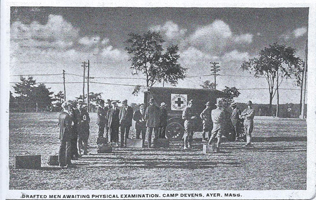
Devens, MA
Dear Mother
I arrived here safely at twelve. Was some tired you bet. What time did Roscoe get home. I wish I was home so I could help you. Hope all of you well. From your loving son


Dear Mother
I have been down to Ayer today. I bought my dinner down there. I went down with Harold Elmer Nobel and the men that worked up to [?]Gurnses. Saw Katherin and the Lorches off. This is the building that we stay in. We have to be in front every morning to report. Will write a letter before long. Your loving son
And another from Devens, postmarked 18 Oct 1917:
Dear Mother
I expect to come home Sat on the half past three if I can get off at seven so I can catch the eight o clock train. I was talking with the captain about you not coming up and told him I would to get off he told me he would give me Sat and Sun any way Maybe longer. Heman
And to Lewis from Atlanta, written in pencil, postmarked 15 November 1917:


Nov. 14, 1917
Dear Brother
How are you getting along these fine days. Suppose you have shot a lot of game by this time. I thought I would send a postcard seeing I hadn’t wrote to you.
From Your Brother
Heman
From France…
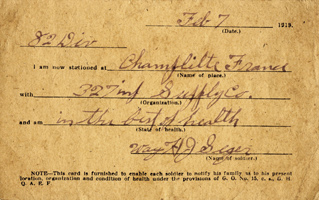
AEF soldiers were issued form postcards to send home, which gave minimal information to anxious families and bore a censor’s OK on the front. His mother saved these postcards.
The following letter written shortly after Heman arrived in France, also survived. The lined paper bears a YMCA logo:
May 8, 1918/Somewhere in France
Dear Mother and all the rest
I landed here safe and sound got off the boat last night. Were twelve days and nights had pretty good weather on the water. I wasn’t very sick only missed a few meals. We took a long way about across. I guess once we were pretty close to Greenland. Didn’t see many fish saw one shark he was quite a large one. I haven’t slept much for the last three nights. last night we rode on the train all night and landed in camp about nine o'clock. It seems to be quite a nice place around here. Don’t see many stones. I believe I wouldn’t mind farming on some of the places. I saw lots of land as level as a house floor.
When we marched through the streets the girls cheered us there are a lot of us them over here. I saw ______ the street car____ ad a man______ also driving on [here and for the following lines the paper is torn]
I came across on the sh__ It as a large one_____ … barracks now forty __ … than what we have been living in.
Don’t get any more white bread now. I can’t seem to think of much today but maybe can do better next time.
I guess it is a good thing that I don’t smoke the boys don’t like the smokers very well here. I have seen some nice cows and horse here. I hope every thing is all write home. I suppose you got the card I sent when I left NY it was a red cross card. Tell the boys to be good. I think they are getting it easy.
It made me mad that night when I called up from __ I guess they didn’t connect us very well or there were to many receivers down. I was two hours before I could get a chance to call you up. I left that night about eleven o’clock. I didn’t say anything about moving because we are not allowed to.
I am well and hope you all the same. With love to all the family
Your loving son.
Write soon. Tell Roscoe to write to _______ seem good now to hear from home.
and later…
… I was leaving quarters to go back to my ward, when I had to wait to let a large contingent of troops march past me along the main road that ran through our camp. They were swinging rapidly towards Camiers, and though the sight of soldiers marching was now too familiar to arouse curiosity, an unusual quality of bold vigor in their swift stride caused me to stare at them with puzzled interest.
They looked larger than ordinary men; their tall, straight figures were in vivid contrast to the under-sized armies of pale recruits to which we had grown accustomed. At first I thought their spruce, clean uniforms were those of officers, yet obviously they could not be officers, for there were too many of them; they seemed, as it were, Tommies in heaven. Had yet another regiment been conjured out of our depleted Dominions? I wondered, watching them move with such rhythm, such dignity, such serene consciousness of self-respect. But I knew the colonial troops so well, and these were different; they were assured where the Australians were aggressive, self-possessed where the New Zealanders were turbulent.
Then I heard an excited exclamation from a group of Sisters behind me.
"Look! Look! Here are the Americans!"
“Over There”
Written by George M. Cohan in April 1917; sung by Arthur Field.

in that little kind of a tower”
Dear Brother (to Lewis)
This picture shows part of the beach. I went up those stairs in that little kind of a tower and look at a little place through my field glasses.
Your Brother

Just a line to let you know I am well and expect to start toward home soon. This card shows the names of the fronts we were on. We have been having some pretty good weather lately. I hope to see you all in April. Your friend, H.J.S.

“To my Dear Mother / A kiss from France”
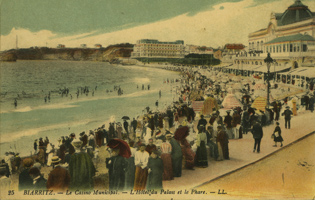
Dear Mother
Just a note to let you know I am well and enjoying myself. I am off on a seven days pass. I am in a nice place It is a summer resort. This card shows the beach where I go every day it is a dandy place. Your son Heman


I went to the Spanish border today.
Dear Brother (to Roscoe)
I am having some time this week while I am on my pass. It is some beautiful place [?] madamsells. I am getting real sporty going to get my fingernails manicured tomorrow by a nice little dame Ha Ha
Your Brother H.J.S.

saved by the family
The U.S. Army Center of Military History provides information and links about various units. From their files and other links on the Web I’ve been able to learn a bit more about the AEF in France. Mabel Seger’s censor-approved postcards from Heman give his Brigade (82nd Division) and Regiment (327th Infantry Supply Co.), which was one of two Infantry Regiments that comprised the 164th Brigade, along with Artillery, Machine Gun and Engineers. As a man accustomed to handling ox and horse teams in civilian life, he was a good candidate for handling wagons and horses for the Army.
The other Infantry Regiment, the 328th, was the unit of of Corporal (later Sergeant) Alvin York, the second but more famous member of the 82nd to receive the Congressional Medal of Honor. The 82nd Division hit the trenches by June 25, 1918, and later took part in the Meuse-Argonne offensive, one of the last battles of the war.

carefully saved:
Discharged Soldier
A diary of another Army Wagoner who saw action in the Argonne is available online and gives a vivid description of the conditions he faced: Battle In The Argonne From The Diary of Waggoner James Elmer Pierson.
Openlibrary.org offers the text of Official History of 82nd Division, American Expeditionary Forces, “All American” Division, 1917-1919 Written by Divisional Officers.
Even in the dry official narrative there are descriptions of trench battle that are harrowing. I had wondered about Bordeaux, and in this search found that combat brigades turned in their gear and were transported by train to the new Division Headquarters in Castres. When the fighting stopped, the authors offer this:
in the Bordeaux area, troops were required to drill but two hours a day, and to occupy their spare time many devices were employed. Major Cunningham was appointed athletic and welfare officer ; a baseball league was organized ; shows were organized in the Division, and additional shows secured from Bordeaux and booked throughout the area; movies were provided, and leaves on a liberal scale to the nearby leave areas were arranged. Practically every man entitled to leave was able to get away.
And with no suggestion of whatever hell he had been through in the preceding months, Heman had time to write postcards.
1917 Military Census
A database on Ancestry.com included a Connecticut military census that appears to have been given to every adult male who could theoretically be drafted for service in the World War, which the United States entered on April 6, 1917. These records were submitted a month before the official declaration of war. Of course we have no idea, at least at with currently available documents, what they thought of the war, then in its third bloody year, or the possibility of being called up. Dry data, except that I was able to learn the height, weight and stated skills of this generation of male relatives.
How tall were they? Could they swim? Handle a boat? Drive an auto? Heman was the only one to see active service.
Walt Jennings and his son Dick had experience with steam engines. Walt and his son Jim claimed that they were good swimmers. Everyone could drive a team; no one was comfortable driving gasoline conveyances. Walter Jennings was six feet tall; his son Dick claimed to be, although we remember a somewhat shorter man. Jim was a bit stockier at 5'9". Only the two youngest, Lew and Dick, lived long enough for me to know them.
[Click on an image below for an enlargement.]
One later story about a farm hand who returned from World War I, Frederick “Doc” Jordan.
Neighbors and Cousins
A photo survives in the Jennings family archives of two of the sons of John Henry Richards and Louise Soule (sister of Lillian Soule Jennings). On the left Noble Charles (13 Jan 1887 –); on the right, his brother Jesse Wheeler (14 June 1885 –). The Richards family farmed a huge tract of land in East Kent and Bromica, east of the Seger farms.Heman mentions Noble, among others who must have joined up at the same time, in one of his postcards from Fort Devens, MA, the first stop on their journey to France.

World War Two
The Town of Kent has been fortunate to have a detailed record of service for its Second World War veterans. By March 1942, townspeople had undertaken a monthly letter-writing project for “every Kent boy” (and eventually eight women) serving, and sent local news, chat and change-of-address cards, along with a variety of goods: cash, toiletries, and fruit cakes among them.
These letters, and the replies from service people, were rediscovered in the old Kent Volunteer Firehouse attic in 2005, and became the kernel for One Small Town in World War II, compiled and written by Francelia Johnson and Charlotte Lindsey of the Kent Historical Society. This is available for purchase online and has provided some of the information here.
Paul John Seger
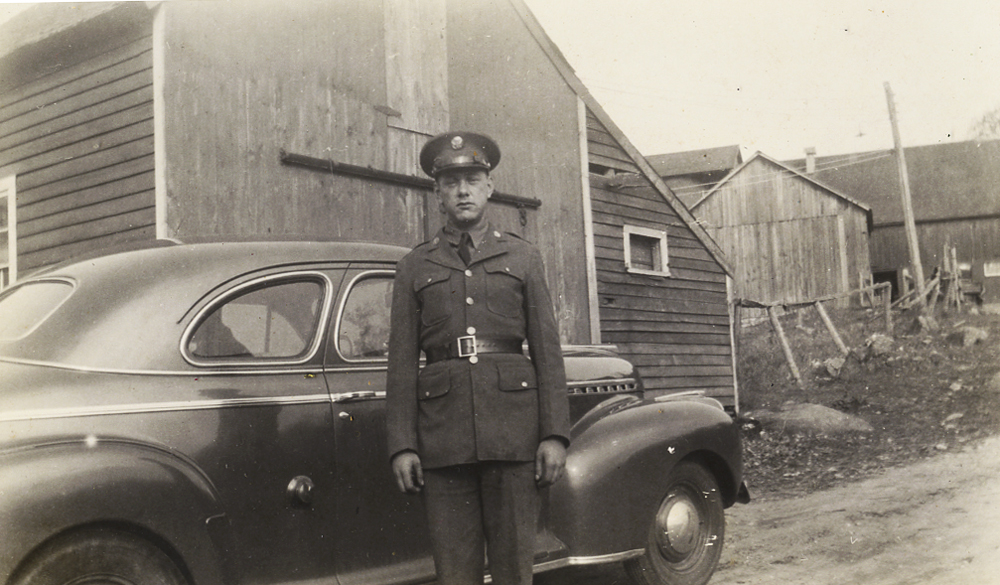
Uncle Bart. Heman’s youngest brother.
[This copy is excerpted from One Small Town in World War II, compiled by Francelia Johnson and Charlotte Lindsey.]
PAUL J. SEGER served in the Army as a Rifleman with WDPC SCU #1160 in Ardennes and central Europe. He entered on Aug.1, 1941. He earned the European African Middle Eastern Ribbon, the American Defense Ribbon, the American Theater Ribbon, WWII Victory Ribbon, an Combat Infantry Badge, the Presidential Citation, 2 Bronze Service Stars and a Good Conduct Medal. He was honorably discharged on Jan. 29, 1946, having reenlisted in the regular Army WD Cir 310 in 1945., War Dept. Center, Fort Devens, MA, thus having served two enlistments. He spent 2 years, 4 months and 9 days stateside and 2 years, 1 month and 19 days overseas. In one VMail, dated Novewmber 11, 1943, he wrote “how much I enjoy receiving your grand letter and that you haven’t forgotten me.” and “You must know by now that I am across the Pond.”

watercolor by David Armstrong
Dates of service: 1 Aug 1941 to 29 Jan 1946
Grade: Private
Military occupational specialty and number: Rifleman 745
Military qualification: SS-Carbine & MG 50 cal.
Battle and campaigns: Ardennes, Central Europe
Decorations and citations: European, African, Middle Eastern Ribbon, American Defense Ribbon, American Theatre Ribbon, Good Conduct Medal, Victory Ribbon, Combat Infantry Badge, Presidential Unit Citation, 2 Bronze Service Stars
“Bart told me he was in the Battle of the Bulge and he froze his feet, but that’s about all I remember.”
Henry Ward

Henry was not a member of the immediate family. (Genealogists and Kent historians may smile at this distinction: his mother Millie was Jim Jennings’ first cousin; Henry’s grandmother was Lillian Soule Jennings’ sister Medora. This is the only cross-pollination I’ve bothered to track; there is doubtless more.) His parents farmed down the mountain from Jim and Lucy’s. He was a close friend of my father Sonny Jennings. In his narrative I was struck by how the Army was able to give him some flexibility to accommodate his needs as the only son on a farm, and how farm experience helped him in his grim assignment in the Ardennes in the winter of 1944-45.
Dates of service: 6 June 1944 to 15 August 1945
Grade: Private
Military occupational specialty and number:
Rifleman, Company A, 289th Infantry Replacement with the First Army
Military qualification: SS-Carbine & MG 50 cal.
Battle and campaigns: Ardennes, Central Europe
Decorations and citations: European African Middle East Theater Ribbon,
one Bronze Battle Star and Combat Infantry Badge
This copy is excerpted from One Small Town in World War II, compiled by Francelia Johnson and Charlotte Lindsey, with permission of Stan Jennings, who conducted the interview with Henry in 2006.
Back to topHenry was 24 when he received basic army infantry training at Camp Croft near Spartanburg, NC. He received a 10 day furlough in November 1944, during which time he butchered 5 young steers he had been raising.
His unit was shipped to England on the USS Wakefield. He remembers volunteering for KP to relieve the boredom and to get better food, including ice cream) and from England to France in the winter of 1944/45.
The … harbor at LeHavre, France was “smashed to pieces.” They were issued WWI era bolt-action Springfield rifles which were packed in cosmolene. Having no solvent to remove the coating the soldiers heated the barrels enough to melt the cosmolene. Sometime thereafter they were issued Garand semi-automatic rifles.
Henry remembers being shuttled around a lot end eventually they were sent to the front where he and three others’ duties were to load bodies on a truck. Being a farm boy all his life and involved with the blood and dismemberment that comes with butchering animals he was able to take the lead in the task without throwing up. He also remembers hours of boredom and watching card playing for high stakes (Henry told me he didn’t know how to gamble then). He remembers an 18-year-old soldier named McPherson winning $1600 and being shot and killed by a stray bullet during a game…
His unit was sent into the fighting in the Battle of the Bulge in February with the ground frozen (making it impossible to dig foxholes with their helmets as they and been taught). He remembers marching all day and all night and wading a river in the wrong area; a buddy near him getting both legs blown off with a shell (he never saw him again) and sleeping on the ground in 12 to 18 inches of snow. Finally, the weather cleared and Henry remembers airplanes in the sky as far as could be seen.
He was examined and tagged for frozen feet. Her said he didn’t feel pain at the time. He was sent to England for recovery and then to Scotland where he was flown home via Iceland, Greenland, Newfoundland and eventually New York. During the flights one plane lost an engine and one had a heater fail (they had lots of blankets, but still cold). Henry remembered the letter writing program.
Henry Grisell
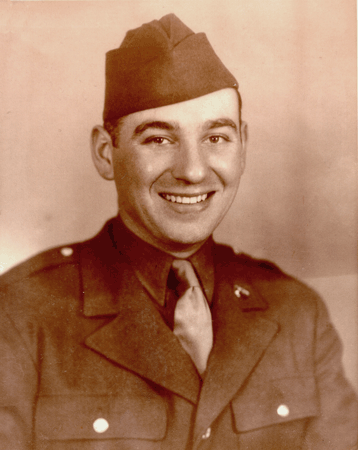
Henry was married to Irene Jennings before his enlistment in the Army. While their marriage ended in divorce in the late 1940s, I want to include his story here, both to flesh out the family story and to preserve the immediacy of his anecdotes, again: the personal narrative of one soldier in the vast narrative sweep of war. Henry's daughters, half-sisters Mary Lou and Susan have helped me with information.
Marion J. Chard has created an extensive archive for the VI Corps Combat Engineers, including the 36th Regiment at VI Corps Combat Engineers of WWII. It is from her site that I have excerpted the following description of the campaigns in which the Engineers participated. John Huston’s 1945 film The Battle of San Pietro documents one part of the Allied efforts to take Italy and is available on YouTube.
36th Engineer Combat Regiment
Activation: The unit was activated at Plattsburgh Barracks New York, 1 June 1941, with two battalions. In September 1942, a battalion from the 540th Engineer Combat Regiment was disbanded and became the 36th's 3rd battalion. The 36th continued to work as a three battalion unit throughout the war.
D-Day Landings:
- Algiers & Fedela North Africa
- Licata Sicily
- Salerno
- Anzio Italy
- Cavaliere Southern France
Campaigns:
- Algiers-Morocco
- Tunisia
- Sicily
- Naples-Foggia
- Anzio
- Rome-Arno
- Southern France
- Rhineland
- Ardennes-Alsace
- Central Europe
Decorations and citations: European African Middle East Theater Ribbon, one Bronze Battle Star and Combat Infantry Badge
Contributed by his daughter Mary Lou Krol:What I know of my father’s war years.
Henry enlisted in 1943 and was sent to Ohio before being sent to Georgia for engineering training – only it never happened. He and a number of other men were picked out and sent directly over to Africa. He got to Africa (at some point he was on a duck crossing the Mediterranean when he got the bright idea of heating a can of beans on the manifold. The can exploded, and the duck was stalled for about an hour), and went east before taking part in the various invasions of Italy, picking up a case of malaria along the way. He told me that he was in every major European theater except Normandy. He was a combat engineer; later a gunner.
Going up the boot of Italy in a dry and dusty season, they passed villages where pasta had been hung out to dry, only to be covered with the dust kicked up by army vehicles. He and his fellow soldiers, not having had fresh food for some time, pigged out on grapes and figs, with the predictable results. Fortunately, they weren’t embattled at the time. He also saw the 1944 eruption of Vesuvius.
He told me things in bits and pieces, so they’re vignettes in my mind, and I don’t know where any of them happened. His wallet stopped a bullet, which shattered the glasses in his pocket. One of the men in his regiment was a professional horse thief, whose nose was put very much out of joint when the men started guarding their belongings — he was after all a specialist, and wasn’t about to make off with anything other than a horse.
There were prisoners of war, too — no hatred there, according to H.G., just the awareness among soldiers that they were all in the same boat, just on different sides. (A neighbor , who like my father was part German, while in his cups used to agonize about choking a German soldier to death “with these hands….” Spreading his fingers and staring down at his palms.) He also mentioned convoys moving by moonlight, and the terrifying effect of the bagpipers in English divisions on the Germans.
At some point he was in both France and Germany, and I believe he saw some of the death camps. He brought back photos taken by another man, and had no patience with the idiots who persisted in denying the Holocaust.
My mother spoke once about the time after the war, when they expected him home any day. She and his parents were cutting corn in Roberts’s lot (down across the railroad tracks) by moonlight on an October night. I never asked her whose corn it was, or why they were cutting it at night, or for that matter, who Roberts was, but I can place myself in that field on a mild Autumn night, and imagine her glancing up towards the house, waiting for the sound of a motor and the sight of headlights coming up the road, stopping at the barn….but that was not when he returned.
I have few facts – I don’t even know what division he was in – not under Patton, for which I believe he was very grateful. At any rate, this is what I pulled out of the ragbag of recollections. One thing that I couldn’t find last time I looked, and which I fear is lost, was a newspaper photo of a group of combat engineers. The family saw it and recognized him, and finally knew where he was – something they had been trying unsuccessfully to piece together from his censored letters.
Back to topI don’t have many stories to tell about his time in the service as he would never really talk about it much to me. I know he saw things that no young man should ever have to see. I know he was the first in at many places and I know he's lucky to have survived it all. There was a drawer of photos that I was never to look at and I took him at that and never did. I believe they were from the concentration camps when they first were there to “liberate” people. These photos were given to a historical society in Florida that was doing a whole WWII area and lots of information there. I know he gave several interviews to these people as well. But I don’t have any of it.
He has spoken a good deal about it to my husband and some to our son, who was always very interested and would sit for hours hearing about things. Although I'm sure dad never told him anything more than "fun" things he did and saw, places he'd been and of course I'm sure my son had him describe equipment and weapons in great detail.
I know the stories about being busted in rank for playing poker, the confiscating of wine and chickens at farms along the way. I know he would never eat lamb due to something he'd seen, but we left it there.
I also know that when he and my mom were touring in Europe one time the tour guide started telling the people about things that happened there during WWII and dad got a bit angry because it was not true and he apparently set the whole group straight. I think the young guide was happy for the information in the end, but I'm not sure it started out well.
I also remember (and this could be fuzzy in my head) but there was some story about Grandma not hearing from him for some time, then seeing him in a group photo in Life Magazine or something and then knowing he was safe.



